大学英语课堂Presentation——Animal
英语《Animals》说课稿
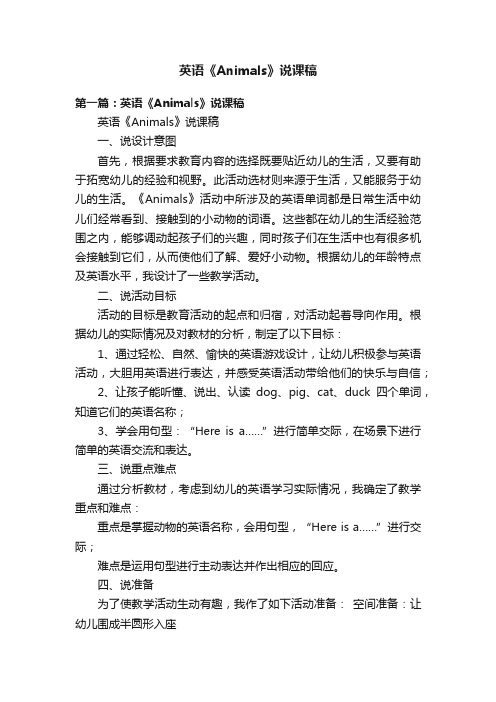
英语《Animals》说课稿第一篇:英语《Animals》说课稿英语《Animals》说课稿一、说设计意图首先,根据要求教育内容的选择既要贴近幼儿的生活,又要有助于拓宽幼儿的经验和视野。
此活动选材则来源于生活,又能服务于幼儿的生活。
《Animals》活动中所涉及的英语单词都是日常生活中幼儿们经常看到、接触到的小动物的词语。
这些都在幼儿的生活经验范围之内,能够调动起孩子们的兴趣,同时孩子们在生活中也有很多机会接触到它们,从而使他们了解、爱好小动物。
根据幼儿的年龄特点及英语水平,我设计了一些教学活动。
二、说活动目标活动的目标是教育活动的起点和归宿,对活动起着导向作用。
根据幼儿的实际情况及对教材的分析,制定了以下目标:1、通过轻松、自然、愉快的英语游戏设计,让幼儿积极参与英语活动,大胆用英语进行表达,并感受英语活动带给他们的快乐与自信;2、让孩子能听懂、说出、认读dog、pig、cat、duck四个单词,知道它们的英语名称;3、学会用句型:“Here is a……”进行简单交际,在场景下进行简单的英语交流和表达。
三、说重点难点通过分析教材,考虑到幼儿的英语学习实际情况,我确定了教学重点和难点:重点是掌握动物的英语名称,会用句型,“Here is a……”进行交际;难点是运用句型进行主动表达并作出相应的回应。
四、说准备为了使教学活动生动有趣,我作了如下活动准备:空间准备:让幼儿围成半圆形入座物质准备:标注英语单词的动物图片、动物布偶、小动物头饰五、说教法《纲要》指出:“教师应成为学习活动的支持者、合作者、引导者。
”活动中应力求形成“合作探究式”的师幼互动。
因此,本次活动我除了用饱满的情绪影响孩子,以自己的形态感染幼儿外,还采用了适宜的方法组织教学,主要教法有:1、游戏法:游戏是幼儿的基本活动,它具有教育性、娱乐性、创造性。
幼儿又有好动的特点,所以在教学过程中穿插适当的游戏,使幼儿能在快乐的游戏中轻松学习。
完整版Animals动物英语课件
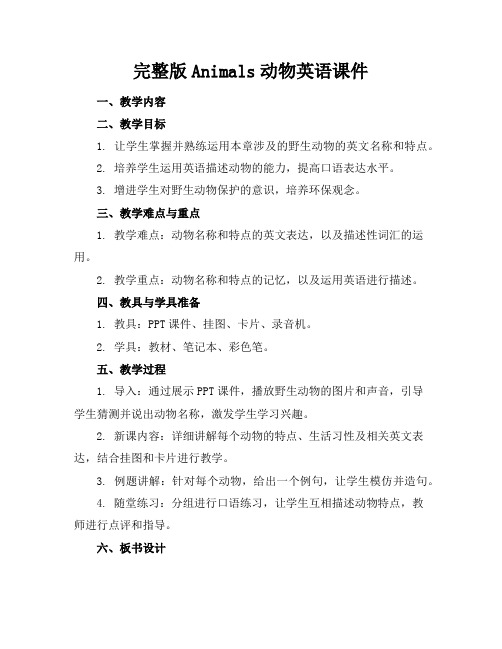
完整版Animals动物英语课件一、教学内容二、教学目标1. 让学生掌握并熟练运用本章涉及的野生动物的英文名称和特点。
2. 培养学生运用英语描述动物的能力,提高口语表达水平。
3. 增进学生对野生动物保护的意识,培养环保观念。
三、教学难点与重点1. 教学难点:动物名称和特点的英文表达,以及描述性词汇的运用。
2. 教学重点:动物名称和特点的记忆,以及运用英语进行描述。
四、教具与学具准备1. 教具:PPT课件、挂图、卡片、录音机。
2. 学具:教材、笔记本、彩色笔。
五、教学过程1. 导入:通过展示PPT课件,播放野生动物的图片和声音,引导学生猜测并说出动物名称,激发学生学习兴趣。
2. 新课内容:详细讲解每个动物的特点、生活习性及相关英文表达,结合挂图和卡片进行教学。
3. 例题讲解:针对每个动物,给出一个例句,让学生模仿并造句。
4. 随堂练习:分组进行口语练习,让学生互相描述动物特点,教师进行点评和指导。
六、板书设计板书分为两部分:左侧列出动物名称,右侧列出相关描述性词汇。
板书简洁明了,突出重点。
七、作业设计1. 作业题目:(1)写出本章涉及的野生动物的英文名称。
(2)用英文描述其中一个动物的特点和生活习性。
(3)针对野生动物保护,提出至少三条建议。
答案:(1)Lion, tiger, elephant, giraffe, bear, monkey.(2)The lion is known as the king of beasts. It has a strong body, sharp teeth and claws. Lions live in groupscalled prides and mainly feed on meat.(3)Suggestions for wildlife protection:Establish wildlife reserves to protect their habitats.Ban hunting and illegal trade of wild animals.Raise public awareness of wildlife conservation.八、课后反思及拓展延伸本节课通过实践情景引入、例题讲解、随堂练习等多种教学方式,使学生掌握了野生动物的英文名称和特点。
大班英语优秀教案《animals》
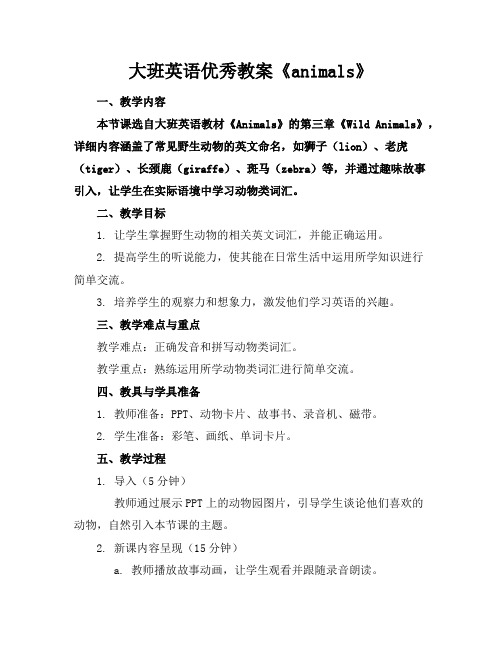
大班英语优秀教案《animals》一、教学内容本节课选自大班英语教材《Animals》的第三章《Wild Animals》,详细内容涵盖了常见野生动物的英文命名,如狮子(lion)、老虎(tiger)、长颈鹿(giraffe)、斑马(zebra)等,并通过趣味故事引入,让学生在实际语境中学习动物类词汇。
二、教学目标1. 让学生掌握野生动物的相关英文词汇,并能正确运用。
2. 提高学生的听说能力,使其能在日常生活中运用所学知识进行简单交流。
3. 培养学生的观察力和想象力,激发他们学习英语的兴趣。
三、教学难点与重点教学难点:正确发音和拼写动物类词汇。
教学重点:熟练运用所学动物类词汇进行简单交流。
四、教具与学具准备1. 教师准备:PPT、动物卡片、故事书、录音机、磁带。
2. 学生准备:彩笔、画纸、单词卡片。
五、教学过程1. 导入(5分钟)教师通过展示PPT上的动物园图片,引导学生谈论他们喜欢的动物,自然引入本节课的主题。
2. 新课内容呈现(15分钟)a. 教师播放故事动画,让学生观看并跟随录音朗读。
b. 教师出示动物卡片,引导学生学习新词汇,如:lion、tiger、giraffe、zebra等。
c. 教师带领学生进行单词接龙游戏,巩固所学词汇。
3. 实践情景引入(10分钟)教师设置一个动物园的场景,让学生扮演小导游,用所学动物类词汇为游客介绍各种动物。
4. 例题讲解(5分钟)教师出示例题:“What's this? It's a(n) ”,引导学生用所学动物类词汇回答。
5. 随堂练习(10分钟)a. 教师出示单词卡片,学生抢答。
b. 学生分成小组,进行动物词汇接龙比赛。
六、板书设计1. Animals2. 内容:列出本节课学习的动物类词汇,如:lion、tiger、giraffe、zebra等。
七、作业设计1. 作业题目:用所学动物类词汇编写一段话,描述你喜欢的动物。
答案示例:My favorite animal is the lion. It's very strong and brave.2. 画一幅动物园的画,并标注出各种动物的英文名称。
《Animals》教学教案
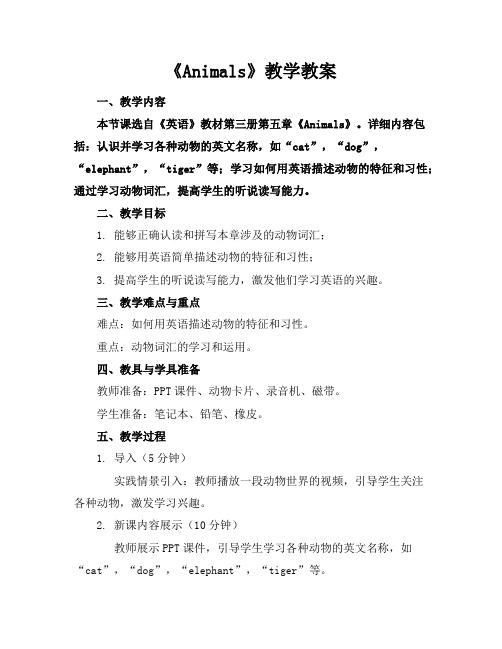
《Animals》教学教案一、教学内容本节课选自《英语》教材第三册第五章《Animals》。
详细内容包括:认识并学习各种动物的英文名称,如“cat”,“dog”,“elephant”,“tiger”等;学习如何用英语描述动物的特征和习性;通过学习动物词汇,提高学生的听说读写能力。
二、教学目标1. 能够正确认读和拼写本章涉及的动物词汇;2. 能够用英语简单描述动物的特征和习性;3. 提高学生的听说读写能力,激发他们学习英语的兴趣。
三、教学难点与重点难点:如何用英语描述动物的特征和习性。
重点:动物词汇的学习和运用。
四、教具与学具准备教师准备:PPT课件、动物卡片、录音机、磁带。
学生准备:笔记本、铅笔、橡皮。
五、教学过程1. 导入(5分钟)实践情景引入:教师播放一段动物世界的视频,引导学生关注各种动物,激发学习兴趣。
2. 新课内容展示(10分钟)教师展示PPT课件,引导学生学习各种动物的英文名称,如“cat”,“dog”,“elephant”,“tiger”等。
3. 例题讲解(10分钟)教师挑选几个动物,用英语描述它们的外观和习性,引导学生模仿。
4. 随堂练习(10分钟)学生两人一组,互相用英语描述手中的动物卡片,巩固所学内容。
5. 小组活动(10分钟)教师将学生分成小组,每组选择一个动物,用英语制作一份关于该动物的介绍海报。
6. 成果展示(10分钟)各小组展示海报,其他同学认真倾听,互相学习。
教师对学生的表现进行点评,强调重点内容,解答疑问。
六、板书设计1. 动物词汇:cat, dog, elephant, tiger,2. 描述动物的特征和习性的句子:The cat is cute. It likes to sleep.七、作业设计1. 作业题目:用英语描述你最喜欢的动物,并说明原因。
答案示例:My favorite animal is the panda. It is very cute and I like its black and white fur.2. 课后练习:根据所学内容,编写一段关于动物的小对话。
完整版Animals动物英语课件
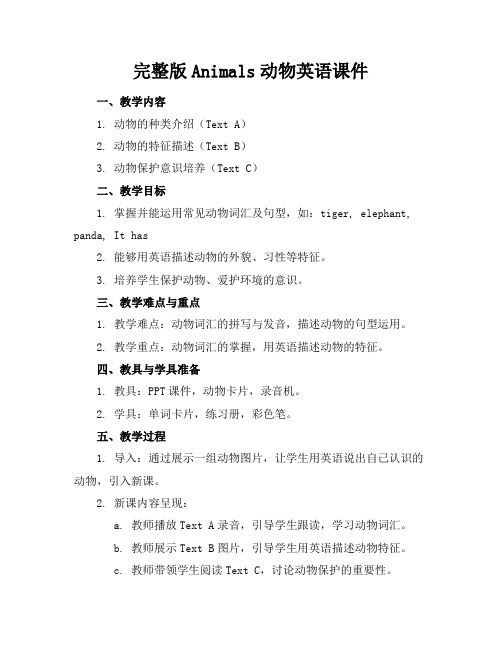
完整版Animals动物英语课件一、教学内容1. 动物的种类介绍(Text A)2. 动物的特征描述(Text B)3. 动物保护意识培养(Text C)二、教学目标1. 掌握并能运用常见动物词汇及句型,如:tiger, elephant, panda, It has2. 能够用英语描述动物的外貌、习性等特征。
3. 培养学生保护动物、爱护环境的意识。
三、教学难点与重点1. 教学难点:动物词汇的拼写与发音,描述动物的句型运用。
2. 教学重点:动物词汇的掌握,用英语描述动物的特征。
四、教具与学具准备1. 教具:PPT课件,动物卡片,录音机。
2. 学具:单词卡片,练习册,彩色笔。
五、教学过程1. 导入:通过展示一组动物图片,让学生用英语说出自己认识的动物,引入新课。
2. 新课内容呈现:a. 教师播放Text A录音,引导学生跟读,学习动物词汇。
b. 教师展示Text B图片,引导学生用英语描述动物特征。
c. 教师带领学生阅读Text C,讨论动物保护的重要性。
3. 例题讲解:讲解动物词汇的拼写和发音,举例说明如何用英语描述动物特征。
4. 随堂练习:让学生两人一组,用所学词汇和句型进行对话练习。
六、板书设计1. 动物词汇:tiger, elephant, panda, lion, giraffe, zebra2. 描述动物特征的句型:It has,It is七、作业设计1. 作业题目:a. 抄写动物词汇,每个写5遍。
b. 用所学句型,写一段关于自己喜欢动物的描述。
2. 答案示例:a. (略)b. My favorite animal is the panda. It has black and white fur. It is very cute. The panda mainly eats bamboo.八、课后反思及拓展延伸1. 课后反思:教师应关注学生在课堂上的表现,了解他们对动物词汇和句型的掌握情况,对教学效果进行评估,不断调整教学方法。
大学英语动物ppt

Puppy or doggie
Endangered Animals
1.The ancient and fashionable panda
The brief introduction of panda
Not only he is vare ,endangered and endemic but also he is very ancient. Now they only distributed in the bamboo forest of mountains in Sichuan Shanxi and Gansu Pthis kind of bired has better environment than befor.there are about 2000 wild birds in our country.
苏门答腊虎The Sumatran tiger
• Only distributed in Indonesia „s Sumatra island (印度尼西亚的 苏门答腊岛). Habitat environment from plain forest to alpine. The only remaining wild Sumatran tiger is about400-500, mostly on the island of Indonesia in the five national park .
Existing condition
According to the authoritative department statistics there are only 1500-2000 Golden Monkeys in the world.
3. Yangtze River Dolphin
英语宠物英文介绍presentation
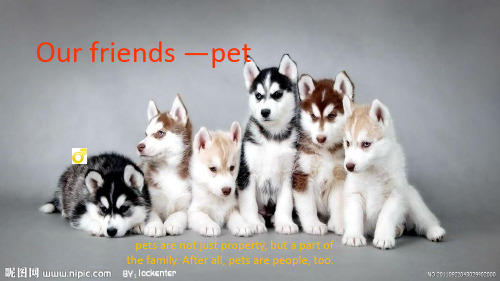
• 3 Reptiles(爬行类 ): turtle龟 snake蛇
• 4 Fish: goldfish tropical fish
Let’s see some different kinds of pets
Pet Types
• 1 Mammalians(哺乳类): dog, cat, rabbit, pig, elephant
• 2 Birds :parrot鹦鹉 pigeon鸽 magpie喜鹊
• Parrots have beautiful feathers and some parrots can imitate sounds and repeat words and Churchill and sentences .
What is a pet?
• A family
In America, there are more families with pets than those with children. Many pet owners treat their furry friends as part of the family. Although they are not human beings, their behavior sometimes is better than the human beings, for they always remain obedient and loyal to the master.
What is a pet?
• A alive “toy”
It sometimes occurs to pet′s owners that their pets are not only animals but also a toy.Pets,now,are so cute and furry. They can even accompany their owners on vacation. Pets spice up their owners' lives
2024年大班英语优秀教案《animals》

2024年大班英语优秀教案《animals》一、教学内容本节课选自英语教材第五册第二章《可爱的动物》,详细内容包括动物的名称、特征、生活环境以及相关的英语单词和句型。
二、教学目标1. 让学生掌握动物类单词,如:panda、giraffe、elephant、tiger、lion等。
2. 使学生能够运用一般现在时描述动物的特征和生活习性。
3. 培养学生对动物的兴趣,提高保护动物意识。
三、教学难点与重点重点:动物类单词和句型的掌握。
难点:一般现在时在描述动物特征和生活习性时的运用。
四、教具与学具准备教具:动物卡片、PPT、录音机、磁带。
学具:单词卡片、练习本、彩色笔。
五、教学过程1. 实践情景引入(5分钟)利用PPT展示各种动物的图片,引导学生说出动物的名称,激发学生对本节课的兴趣。
2. 新课内容展示(15分钟)(1)教师展示动物卡片,引导学生学习新单词,如:panda、giraffe等。
(2)学习一般现在时描述动物特征和习性的句型,如:The panda is eating bamboo. The giraffe is taller than the elephant.3. 例题讲解(10分钟)教师给出例句,如:The tiger is sleeping. The lion is roaring. 让学生模仿并练习。
4. 随堂练习(10分钟)学生分组,每组选择一个动物,用英语描述其特征和习性,其他组猜测。
六、板书设计1. 动物类单词:panda、giraffe、elephant、tiger、lion等。
2. 句型:The + 动物名称 + is + 动词(ing形式)/ 形容词。
七、作业设计1. 作业题目:用一般现在时描述你最喜欢的动物。
答案示例:My favorite animal is the panda. The pandais eating bamboo. It is very cute.2. 作业题目:模仿课堂练习,用英语描述一个物品或人物。
【英语课presentation】人类的朋友——大猩猩

Today I'm going to introduce an animal which is much similar to humans. It is chimpanzee(黑猩猩).Chimpanzees live in the rain forests in Central Africa. They can live as long as 40 years. During the day they spend several hours searching for food. In the night they sleep in trees.We can find humanity in chimpanzees. They have the instinct to feel others’emotions. They try to understand what their partners are thinking by looking at things in their partners' view. Chimpanzees also use facial expressions and a special language to communicate with each other.Some people think that we human being is much cleverer than any other species. They turned out to be wrong. We can find the society of chimpanzees as complicated as ours. Chimpanzees live in groups. A group contains 15-80 individuals and is usually led by a male chimpanzee. The leader's duty is to protect his group members and make sure that everyone is doing his job. Chimpanzees have strict social class system. If one meets another that belongs to a higher class than him, he must show his humbleness and look down to the earth. If he looks straight into his eyes, he will be beaten heavily. The top leader himself has tremendous power. His daily behaviors are simulated by everyone, that's why one group of chimpanzees behave in a different way from another group. Scientists call it "the group culture". The leader can sleep with any female chimpanzee he likes. Generally speaking, females show more interest to the males who have more power, and they believe that to sleep with these guys can bring themselves into the upper class. In fact, two thirds of the kids in a group are the children of the leader and his friends. Other male chimpanzees have to treat them well as they were their own children. Driven by the desire to be a real father, nearly all male chimpanzees are struggling to climb to a higher class. Male chimpanzees compete by severe violence as well as the support of the females who like him. They fight frequently, sometimes are badly hurt. But after fighting, they usually hug and kiss each other, asking for forgiveness. Maybe it is their nature to forgive and to love that holds them together as a large family that is in harmony.When a female chimpanzee grows up, she leaves her home and joins another group, while male ones stay in their group all their life. When a female first comes to a new group, she is not welcomed by other females. But she is usually good at making friends and can find her place soon. When she has babies, they live together as a family. A chimpanzee never knows who his father is. But he loves his mother very much. During his life, the relationship between he and his mother is the most precious gift in a society that is full of danger and struggle. He may be defeated, be cheated or be betrayed by others, but his mother will always stand by him and give him comforts. A chimpanzee who has left home will often go back to see his mother. A child whose mother isdead will be fostered by his senior sister, but he will never be really happy when he grows up.Chimpanzees’social problems are much similar to ours. In an experiment, scientists gave a chimpanzee some money and taught him the use of it. Then they let the chimpanzee return to his group with the money. Before long, scientists found that every chimpanzee had known the value of money and it began to circulate around. What they did with the money was just what humans do in our society. They use the money to purchase friendship and power, and to show their respect to the leader. Males even gave money to females so that he could sleep with her. When we are observing chimpanzees, we feel like we are observing ourselves. In the long process of our revolution, human nature changed little. Our social problems have existed for millions of years and still remain unsolved. So how can we say that we are more advanced than chimpanzees?However, on the other hand, humans and chimpanzees both have the nature of love. We love our relatives, friends and lovers. When they die we shed tears for them. We also have the virtue of giving. Sometimes we sacrifice ourselves for the society’s benefit. At that time we are proud of our selflessnessIn any case, humans and chimpanzees are close relatives. We should do our best to protect them, and respect them. That’s all for my presentation and here are some more pictures.。
英语口语animals动物主题对话5分钟

赵:Nowadays, we can find an interesting phenomenon among dorms of college students that most of students wish to have a pet indoor to relax themselves, or in another word, to be a company.现如今,我们可以发现在大学生寝室有一个现象:很多学生希望在寝室养宠物来娱乐自己,或者用其他话来说,作为一个陪伴。
章:I think some college students keep small animals as their pets is reasonable. The systems ofCollege are too strict. Why students can”t do things they like? They just small animals我认为大学生在寝室养小动物作为他们的宠物是合理的。
学校的制度太严格了。
为什么学生不可以做自己喜欢的事?他们仅仅是小动物而已。
周:My friend kept a dog as a pet in the dormitory.It is a stray dog, but he also made the careful preparation He toke it so well that we all think he can play with the dog. But a week after the teacher found it. The teacher asked him to drop the dog.What school do Is right?我的朋友在寝室里养狗,是一只流浪狗,但是他也为它做了精心的准备, 他对它是如此的精心以至于让我们都以为他可以和这只狗一起玩耍。
英语口语animals动物主题对话5分钟

英语口语animals动物主题对话5分钟第一篇:英语口语animals动物主题对话5分钟赵:Nowadays, we can find an interesting phenomenon among dorms of college students that most of students wish to have a pet indoor to relax themselves, or in another word, to be a company.现如今,我们可以发现在大学生寝室有一个现象:很多学生希望在寝室养宠物来娱乐自己,或者用其他话来说,作为一个陪伴。
章:I think some college students keep small animals as their pets is reasonable.The systems of College are too strict.Why students can”t do things they like? They just small animals 我认为大学生在寝室养小动物作为他们的宠物是合理的。
学校的制度太严格了。
为什么学生不可以做自己喜欢的事?他们仅仅是小动物而已。
周:My friend kept a dog as a pet in the dormitory.It is a stray dog, but he also made the careful preparation He toke it so well that we all think he can play with the dog.But a week after the teacher found it.The teacher asked him to drop the dog.What school do Is right? 我的朋友在寝室里养狗,是一只流浪狗,但是他也为它做了精心的准备, 他对它是如此的精心以至于让我们都以为他可以和这只狗一起玩耍。
大班英语优秀优质教案《animals》

大班英语优秀优质教案《animals》一、教学内容本节课选自《新概念英语》第一册第四章,主题为“Animals”。
详细内容包括认识并掌握各类动物的英文名称,如“cat”、“dog”、“elephant”、“tiger”等,同时学习相关的形容词,如“big”、“small”、“fat”、“thin”等。
二、教学目标1. 学生能够听懂并准确说出各类动物的英文名称。
2. 学生能够用形容词描述动物的特征。
3. 学生能够在实际情境中运用所学词汇进行简单的交流。
三、教学难点与重点1. 教学难点:动物名称及其形容词的准确发音。
2. 教学重点:掌握动物名称和形容词的用法,能够在实际情境中进行运用。
四、教具与学具准备1. 教具:PPT、动物图片、单词卡片、录音机。
2. 学具:学生用书、练习本、彩色笔。
五、教学过程1. 实践情景引入(5分钟)教师展示一个动物园的场景,引导学生说出他们所熟悉的动物。
教师挑选几个学生回答,并在黑板上板书相应的动物名称。
2. 例题讲解(10分钟)教师通过PPT展示各类动物的图片,引导学生学习并掌握动物名称和形容词。
教师对每个词汇进行讲解,并让学生跟读。
3. 随堂练习(10分钟)教师将学生分成小组,每个小组根据所学的动物名称和形容词进行描述,其他小组猜测。
教师挑选几个小组进行展示,并给予评价。
4. 小组活动(10分钟)教师发放动物图片和单词卡片,要求学生将图片与对应的单词进行配对。
学生完成配对后,教师进行检查并纠正错误。
学生复述所学动物名称和形容词。
六、板书设计1. 动物名称:cat、dog、elephant、tiger、monkey、panda等。
2. 形容词:big、small、fat、thin、cute、funny等。
七、作业设计1. 作业题目:用所学的动物名称和形容词写一段话,描述一个你喜欢的动物。
答案示例:I like pandas. They are very cute and fat. They have black eyes and ears.2. 作业要求:字迹工整,语法正确,不少于5句话。
英语鲨鱼presentation

Gnome Angle shark
The Big White shark is considered the biggest shark that attacks people. It has a strong body and often attacks people who is swimming or surfing. Even sometimes attacks small ships. As a large marine predator, the big white shark has a fame that is very cruel. It has an unique skin color, black eyes, evil teeth, this not only makes it be the easiest shark to recognize, but also makes it be the cover of the sea animals.
Every species has its own reason to survive. Now that we human appeared on the earth, we should live in harmony with everything lives on it, not to harm it. Sometimes to protect the shake is just a simple thing if every takes a small step.
When we talk about sharks, we always think that it is a fierce animal, but in fact we may have some misunderstandings. There are 380 kinds of sharks in the world, but only 30 kinds of sharks attack people. 7 of them can lead people to death; other 23 kinds are formed because of their sizes and living habits. Most sharks feed on the injured marine mammals, fish or carrion. Some times they even eat the rubbish thrown from the ship.
《Year Animals》 说课稿
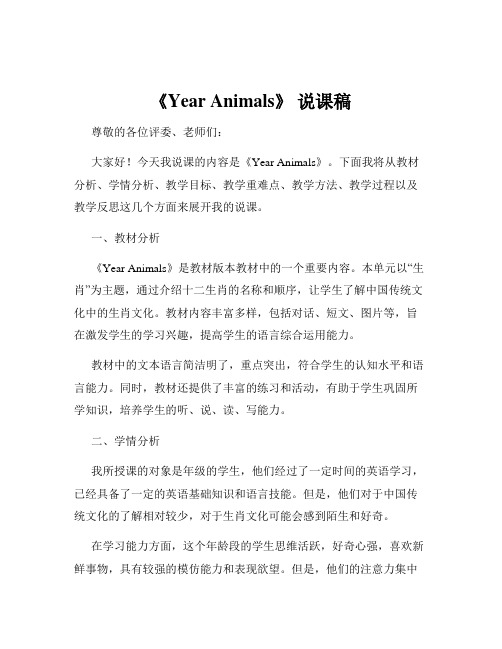
《Year Animals》说课稿尊敬的各位评委、老师们:大家好!今天我说课的内容是《Year Animals》。
下面我将从教材分析、学情分析、教学目标、教学重难点、教学方法、教学过程以及教学反思这几个方面来展开我的说课。
一、教材分析《Year Animals》是教材版本教材中的一个重要内容。
本单元以“生肖”为主题,通过介绍十二生肖的名称和顺序,让学生了解中国传统文化中的生肖文化。
教材内容丰富多样,包括对话、短文、图片等,旨在激发学生的学习兴趣,提高学生的语言综合运用能力。
教材中的文本语言简洁明了,重点突出,符合学生的认知水平和语言能力。
同时,教材还提供了丰富的练习和活动,有助于学生巩固所学知识,培养学生的听、说、读、写能力。
二、学情分析我所授课的对象是年级的学生,他们经过了一定时间的英语学习,已经具备了一定的英语基础知识和语言技能。
但是,他们对于中国传统文化的了解相对较少,对于生肖文化可能会感到陌生和好奇。
在学习能力方面,这个年龄段的学生思维活跃,好奇心强,喜欢新鲜事物,具有较强的模仿能力和表现欲望。
但是,他们的注意力集中时间较短,需要采用多样化的教学方法和活动来吸引他们的注意力,激发他们的学习兴趣。
三、教学目标基于对教材和学情的分析,我确定了以下教学目标:1、知识目标(1)学生能够听懂、会说、认读十二生肖的英文名称:rat, ox, tiger, rabbit, dragon, snake, horse, goat, monkey, rooster, dog, pig。
(2)学生能够理解并运用句型:What is your year animal? My year animal is2、能力目标(1)能够运用所学的生肖词汇和句型进行简单的交流,谈论自己和他人的生肖。
(2)提高学生的听、说、读、写能力,培养学生的语言综合运用能力。
3、情感目标(1)激发学生对中国传统文化的兴趣,增强学生的民族自豪感。
完整版Animals动物英语课件
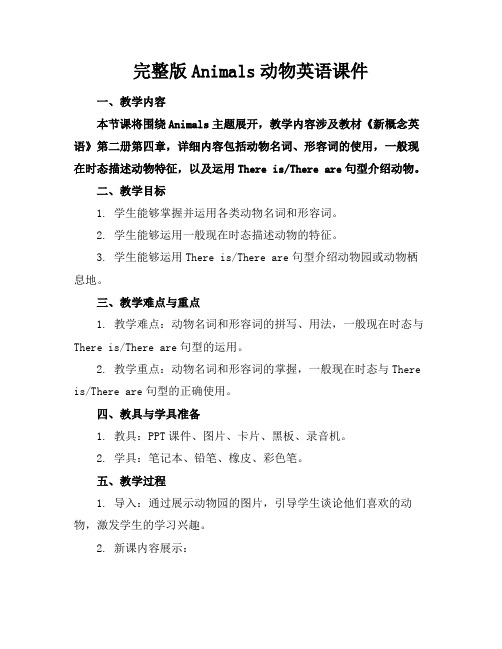
完整版Animals动物英语课件一、教学内容本节课将围绕Animals主题展开,教学内容涉及教材《新概念英语》第二册第四章,详细内容包括动物名词、形容词的使用,一般现在时态描述动物特征,以及运用There is/There are句型介绍动物。
二、教学目标1. 学生能够掌握并运用各类动物名词和形容词。
2. 学生能够运用一般现在时态描述动物的特征。
3. 学生能够运用There is/There are句型介绍动物园或动物栖息地。
三、教学难点与重点1. 教学难点:动物名词和形容词的拼写、用法,一般现在时态与There is/There are句型的运用。
2. 教学重点:动物名词和形容词的掌握,一般现在时态与There is/There are句型的正确使用。
四、教具与学具准备1. 教具:PPT课件、图片、卡片、黑板、录音机。
2. 学具:笔记本、铅笔、橡皮、彩色笔。
五、教学过程1. 导入:通过展示动物园的图片,引导学生谈论他们喜欢的动物,激发学生的学习兴趣。
2. 新课内容展示:a. 教师展示PPT,呈现各类动物的图片,引导学生学习动物名词和形容词。
b. 教师通过例句,引导学生学习一般现在时态描述动物特征。
c. 教师通过PPT,展示There is/There are句型的用法,并举例说明。
3. 实践环节:a. 学生分组,根据所给动物名词和形容词,用一般现在时态描述动物特征。
b. 学生运用There is/There are句型,介绍动物园或动物栖息地。
4. 例题讲解:a. 教师给出例句,如:There is a lion in the zoo. The lion is strong.b. 教师对例句进行讲解,指导学生正确使用动物名词、形容词、一般现在时态和There is/There are句型。
5. 随堂练习:a. 学生根据所学内容,完成练习册上的相关题目。
b. 教师对练习进行讲解,纠正学生的错误。
大学英语演讲稿动物

Ladies and gentlemen,Good morning/afternoon/evening. It is my great pleasure to stand before you today to deliver a speech on a topic that is as vast and diverse as the animal kingdom itself—animals. Animals have been a part of ourlives since the dawn of time, and they hold a special place in our hearts and minds. In this speech, I will explore the various aspects of animals, including their role in our lives, their importance in the ecosystem, and the lessons we can learn from them.Firstly, let us acknowledge the role animals play in our lives. Animals have been our companions, providers, and protectors for centuries. From the domesticated dogs and cats that share our homes to the majestic elephants that roam the African savannahs, animals have been there to offer comfort, loyalty, and companionship. They have been our sources of food, clothing, and even medicine. In many cultures, animals are revered and considered sacred, holding spiritual significance in the lives of their people.Domestic animals, such as dogs, cats, horses, and livestock, have been instrumental in shaping human civilization. They have helped us in farming, transportation, and warfare. Our lives would be unimaginable without the contributions of these loyal creatures. For instance, dogs have been trained as guides for the visually impaired, as search and rescue dogs, and as therapy animals to comfort the sick and elderly. Horses have been our reliable companions in battle, transportation, and agriculture. These animals have not only made our lives easier but have also enriched our emotional experiences.Furthermore, animals are crucial to the functioning of our ecosystems. They play a vital role in maintaining the balance of nature. As predators, they control the populations of herbivores, which in turn helps to maintain the health of plant life. For example, lions andtigers are apex predators that keep the populations of herbivores in check, preventing overgrazing and maintaining biodiversity. Similarly, pollinators such as bees and butterflies are essential for the reproduction of many plant species, ensuring a sustainable food supply.Moreover, animals are not just passive participants in the ecosystem; they also influence it actively. Their behaviors, such as migration patterns and breeding rituals, can have significant ecological consequences. For instance, the annual migration of monarch butterflies from North America to Mexico is a remarkable example of how animals can shape their environment and influence climate patterns.Apart from their practical and ecological roles, animals also serve as teachers and sources of inspiration. Through their resilience, intelligence, and social behaviors, animals impart valuable lessons to us. Here are a few examples:1. Resilience: Animals such as the tortoise and the salamander have adapted to survive in extreme environments, teaching us the importanceof perseverance and adaptability. They show us that even in the face of adversity, life can continue and thrive.2. Intelligence: Dolphins, elephants, and crows are known for their high levels of intelligence. They display problem-solving skills, self-awareness, and the ability to communicate complex ideas. These animals remind us that intelligence is not limited to humans and that there is much to learn from our non-human counterparts.3. Social Behavior: Many animals, such as wolves, elephants, and bees, live in highly social structures and exhibit sophisticated social behaviors. They demonstrate the importance of cooperation, communication, and empathy in building strong communities. These animals teach us that our success as a species depends on our ability to work together and respect one another.In conclusion, animals are an integral part of our lives, playingvarious roles in our society and ecosystems. They are not just creatures to be exploited or admired but rather companions and teachers. As we continue to interact with animals, it is crucial to recognize their importance and to strive to protect and preserve their habitats.Let us learn from the animals around us, respecting their lives and contributing to the conservation efforts that ensure their survival. Bydoing so, we not only honor the wonders of the animal kingdom but also ensure a sustainable future for ourselves and generations to come.Thank you for your attention.。
英语综合实践课保护动物(2篇)

第1篇IntroductionIn today's rapidly changing world, the issue of animal conservation has become increasingly significant. As English integrated practice classes aim to develop students' language skills while fostering a sense ofsocial responsibility, incorporating lessons on animal protection is a valuable addition. This essay will explore various aspects of animal conservation, including the importance of protecting animals, the challenges faced by wildlife, and practical steps that can be taken inan English integrated practice class to educate and inspire students to become advocates for wildlife.The Importance of Protecting AnimalsAnimals play a crucial role in maintaining the balance of our ecosystems. They contribute to biodiversity, which is essential for the health and stability of the planet. Moreover, animals provide us with food, medicine, and other resources. However, human activities have led to the decline of many animal species, threatening the delicate balance of our ecosystems. The following points highlight the importance of protecting animals:1. Biodiversity: Different species of animals have unique roles in their ecosystems. The loss of even a single species can disrupt the entire ecosystem, leading to a cascade of negative effects.2. Food Security: Many animals are a vital source of food for humans and other species. The decline of these species can lead to food shortages and increased competition for resources.3. Medicine and Research: Many animals have been the source of medical breakthroughs and continue to be invaluable for research and development.4. Economic Value: The tourism industry often relies on the presence of wildlife, which can provide significant economic benefits to local communities.Challenges Faced by WildlifeDespite the importance of protecting animals, numerous challenges threaten wildlife around the world. Some of the most pressing issues include:1. Habitat Loss and Fragmentation: Deforestation, urbanization, and other human activities have led to the destruction and fragmentation of natural habitats, leaving animals with limited space to live and reproduce.2. Poaching and Illegal Wildlife Trade: The demand for animal products, such as ivory, fur, and medicinal plants, has driven illegal wildlife trade, leading to the decline of many species.3. Climate Change: Rising temperatures, extreme weather events, and changing precipitation patterns are causing habitat loss and altering food sources for many animals.4. Invasive Species: Non-native species introduced to new environments can outcompete native species for resources, leading to a decline in local biodiversity.Practical Steps in English Integrated Practice ClassTo address the issue of animal conservation, English integrated practice classes can take several practical steps:1. Educational Activities: Incorporate lessons on animal conservation into the curriculum. This can include reading articles, watching documentaries, and discussing case studies.2. Language Skills Development: Use English to discuss the challenges faced by wildlife and the importance of conservation efforts. This can include writing essays, creating presentations, and engaging in debates.3. Creative Writing: Encourage students to write stories, poems, or plays that focus on animal conservation, fostering empathy and a deeper understanding of the issue.4. Project-Based Learning: Assign group projects that require students to research a specific animal species and develop a conservation plan.5. Field Trips: Organize visits to wildlife reserves, sanctuaries, or local conservation projects to provide students with hands-on experience and a better understanding of the challenges faced by wildlife.6. Collaboration with Local Organizations: Partner with local conservation groups to engage students in volunteer opportunities, such as participating in clean-up drives or planting trees.7. Social Media Campaigns: Encourage students to create and share informative posts on social media platforms to raise awareness about animal conservation.ConclusionProtecting animals is a critical issue that requires the collective efforts of individuals, communities, and governments. By incorporating animal conservation into English integrated practice classes, we can not only develop students' language skills but also inspire them to become advocates for wildlife. Through education, awareness, and practical action, we can work towards a future where animals and humans coexist harmoniously in a sustainable environment.第2篇Introduction:Animal protection is a crucial issue that concerns the well-being of all living creatures on Earth. In this English comprehensive practical class, we will explore the importance of protecting animals, discuss the challenges faced by wildlife, and implement practical strategies to promote animal conservation. By the end of this class, students will have a better understanding of the significance of animal protection and the role they can play in this global effort.I. Importance of Protecting Animals1. Biodiversity: Animals contribute to the biodiversity of our planet, playing a vital role in maintaining ecological balance. They help in pollinating plants, dispersing seeds, and controlling pests.2. Ecosystem Services: Animals provide numerous ecosystem services, such as water purification, soil fertility, and climate regulation.Protecting animals is essential for the sustainability of these services.3. Cultural and Economic Value: Animals have cultural and economic significance. They are a source of food, clothing, and income for many people. Additionally, wildlife tourism generates significant revenue for local communities.4. Ethical Considerations: Animals have intrinsic value and deserve to live free from suffering and exploitation. Protecting animals is amatter of ethical responsibility.II. Challenges Faced by Wildlife1. Habitat Loss and Fragmentation: Deforestation, urbanization, and agricultural expansion have led to the loss and fragmentation of animal habitats, causing a decline in their populations.2. Poaching and Illegal Wildlife Trade: Poaching for bushmeat, ivory,and other wildlife products has devastating effects on animal populations. The illegal wildlife trade is a significant threat to endangered species.3. Climate Change: Rising temperatures, changing precipitation patterns, and extreme weather events due to climate change pose a threat towildlife and their habitats.4. Pollution: Pollution from industrial activities, agriculture, and plastic waste affects animals' health and survival.III. Practical Strategies for Animal Protection1. Raising Awareness: Educate people about the importance of protecting animals and the challenges they face. This can be achieved throughschool programs, community events, and social media campaigns.2. Sustainable Development: Promote sustainable practices in agriculture, forestry, and urban planning to minimize habitat loss and fragmentation.3. Conservation Efforts: Support conservation projects aimed atprotecting endangered species, restoring habitats, and enforcing anti-poaching laws.4. Responsible Consumption: Choose sustainable and cruelty-free products. Avoid purchasing wildlife products that contribute to illegal wildlife trade.5. Community Involvement: Encourage local communities to participate in conservation efforts, such as monitoring wildlife populations, reporting illegal activities, and engaging in sustainable livelihoods.IV. Project ImplementationFor this practical class, we will implement a project focused on raising awareness about the plight of pangolins, an endangered species facingthe threat of illegal wildlife trade.1. Research: Students will research the biology, habitat, and conservation status of pangolins. They will also study the causes and consequences of the illegal wildlife trade.2. Campaign Development: Students will create an awareness campaign, including posters, videos, and social media content, highlighting the importance of pangolin conservation.3. Outreach: Students will distribute their campaign materials to schools, community centers, and online platforms to reach a wider audience.4. Fundraising: Students will organize a fundraising event to support pangolin conservation efforts. Proceeds will be donated to reputable wildlife conservation organizations.5. Evaluation: Students will evaluate the effectiveness of their campaign by measuring the number of participants, social media engagement, and donations received.Conclusion:In conclusion, protecting animals is a critical issue that requires our attention and action. By understanding the importance of animal protection, discussing the challenges faced by wildlife, and implementing practical strategies, we can contribute to the conservation of our planet's biodiversity. This English comprehensive practical class aims to empower students to become advocates for animal protection and inspire them to make a positive impact on the world around them.。
英语讲课动物逐字稿模板

英语讲课动物逐字稿模板开场白:Good morning, everyone! Today, we're going to embark on a fascinating journey into the world of animals. This session will be filled with intriguing facts, engaging discussions, and a lot of fun. So, let's dive right in!引入主题:The animal kingdom is vast and diverse, encompassing creatures that live on land, in the sea, and even in the air. Each species has its unique characteristics and adaptations that allow them to thrive in their respective environments.动物分类:Let's start by looking at the broad categories of animals. There are mammals, birds, reptiles, amphibians, fish, and invertebrates. Each category has its own set of features that distinguish them from the others.哺乳动物(Mammals):Mammals are warm-blooded vertebrates that have hair or fur and typically give birth to live young. They are known for their ability to nurse their offspring with milk. Examples include elephants, whales, and of course, humans.鸟类(Birds):Birds are characterized by their feathers, beaks, and the ability to fly. They are warm-blooded and lay hard-shelledeggs. Penguins, eagles, and sparrows are all examples of birds.爬行动物(Reptiles):Reptiles are cold-blooded vertebrates that have scales or scutes. They lay soft-shelled eggs or give birth to live young. Snakes, lizards, and turtles are all reptiles.两栖动物(Amphibians):Amphibians are unique because they can live both in water and on land. They are cold-blooded and have moist, permeable skin. Frogs, toads, and salamanders are typical amphibians.鱼类(Fish):Fish are aquatic vertebrates that have gills to extractoxygen from water and fins to aid in swimming. They come in a wide variety of shapes and sizes, from the tiny guppy to the massive whale shark.无脊椎动物(Invertebrates):Invertebrates make up the majority of animal species on Earth. They lack a backbone and include insects, arachnids, mollusks, and more. Butterflies, spiders, and octopuses are all invertebrates.动物行为:Now, let's talk about animal behavior. Animals exhibit a wide range of behaviors, from hunting and foraging to mating and caring for their young. Some animals migrate long distances, while others hibernate during cold months.保护动物:It's crucial to understand the importance of conservation. Many animal species are endangered due to habitat loss, climate change, and human activities. We must work together to protect these species and their ecosystems.互动环节:Let's have a quick interactive session. Can anyone name an animal from each category we've discussed? Please feel free to share your thoughts.总结:In conclusion, the animal kingdom is a testament to the diversity and adaptability of life on Earth. Each species plays a vital role in the ecosystem, and it's our responsibility to learn about and protect these incredible creatures.结束语:That wraps up our session on animals. I hope you've enjoyed learning about the different types of animals and their behaviors. Remember, every animal is unique and important. Keep exploring and stay curious!This template provides a comprehensive guide for an English lecture on animals, covering various aspects such as classification, behavior, and conservation. It is designed to be engaging and informative, with room for interaction to keep the audience involved.。
大学生动物演讲稿英语

Ladies and gentlemen,Good morning/afternoon. It is my great honor to stand before you todayto deliver a speech on a topic that touches the hearts of many: the bond between humans and animals. Animals have been an integral part of our lives since the dawn of time, and their significance in our world cannot be overstated. In this speech, I will explore the various aspects ofthis bond, highlighting its importance, challenges, and the role itplays in our society.Firstly, let us consider the historical perspective of our relationship with animals. Throughout history, humans have relied on animals for survival. From the domestication of the first domesticated animals, such as dogs and cattle, to the use of animals in agriculture, transportation, and warfare, our reliance on animals has shaped the course of human civilization. The development of tools, the establishment of societies, and the exploration of the world have all been made possible through the assistance of animals.Animals have played a crucial role in our cultural and spiritual livesas well. In many cultures, animals are revered and seen as sacred beings. For example, in Hinduism, cows are considered sacred, and in manyAfrican tribes, certain animals are believed to be spirits or messengers of the gods. These beliefs reflect the deep respect and reverence that humans have for animals, acknowledging their importance in our lives.Moving forward to the present, the bond between humans and animals has evolved in many ways. Pets have become an integral part of many households, providing companionship, love, and support. The popularityof pet ownership has grown exponentially, with millions of people worldwide sharing their lives with animals. This companionship is not only beneficial for the animals but also for humans, as studies have shown that pets can reduce stress, improve mental health, and even enhance social connections.Moreover, animals have become an essential part of our educational system. Zoos, aquariums, and wildlife reserves serve as learning centers, where people of all ages can learn about different species, theirhabitats, and the importance of conservation. These institutions not only provide entertainment but also promote empathy, respect, and a sense of responsibility towards the animal kingdom.However, this bond is not without its challenges. The modern world presents numerous threats to animals, including habitat loss, climate change, pollution, and poaching. These issues have led to a decline in many animal populations, raising concerns about biodiversity and the delicate balance of ecosystems. It is our responsibility to address these challenges and work towards a sustainable future that respects the rights and well-being of animals.In order to strengthen the bond between humans and animals, we mustfirst recognize the intrinsic value of all living beings. Each animal has its own unique qualities, emotions, and experiences, and it is our duty to ensure their protection and well-being. This means adopting ethical practices in agriculture, reducing the consumption of animal products, and supporting initiatives aimed at preserving wildlife and their natural habitats.Furthermore, we must promote education and awareness about animal rights and conservation. By fostering a deeper understanding of the animal kingdom, we can encourage people to take action and become advocates for the protection of animals. This can be achieved through various means, such as documentaries, social media campaigns, and community events that raise awareness about animal-related issues.Another critical aspect of strengthening the bond between humans and animals is the promotion of empathy and compassion. By learning to see the world through the eyes of an animal, we can develop a stronger connection with them and understand their needs and struggles. This empathy can lead to more compassionate choices in our daily lives, such as supporting cruelty-free products and participating in animal welfare organizations.In conclusion, the bond between humans and animals is a vital connection that has shaped our world in countless ways. It is a bond that we must cherish, respect, and protect. By acknowledging the importance of thisconnection, addressing the challenges we face, and promoting empathy and compassion, we can ensure a sustainable future for both humans and animals.In closing, let us remember that we are not alone in this world. The animal kingdom is our family, and together, we can overcome the challenges that lie ahead. Let us work towards a future where humans and animals coexist harmoniously, celebrating the beauty and diversity of life on Earth.Thank you for your attention.。
